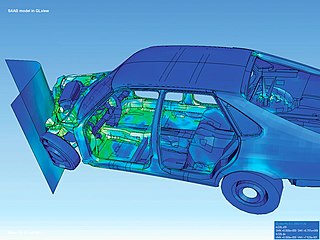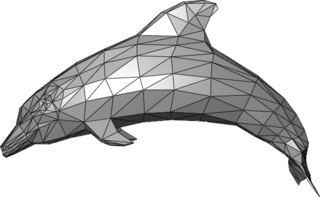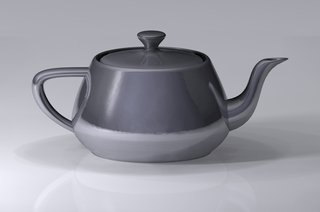Computational geometry is a branch of computer science devoted to the study of algorithms which can be stated in terms of geometry. Some purely geometrical problems arise out of the study of computational geometric algorithms, and such problems are also considered to be part of computational geometry. While modern computational geometry is a recent development, it is one of the oldest fields of computing with a history stretching back to antiquity.

Scientific visualization is an interdisciplinary branch of science concerned with the visualization of scientific phenomena. It is also considered a subset of computer graphics, a branch of computer science. The purpose of scientific visualization is to graphically illustrate scientific data to enable scientists to understand, illustrate, and glean insight from their data. Research into how people read and misread various types of visualizations is helping to determine what types and features of visualizations are most understandable and effective in conveying information.

Visualization or visualisation is any technique for creating images, diagrams, or animations to communicate a message. Visualization through visual imagery has been an effective way to communicate both abstract and concrete ideas since the dawn of humanity. from history include cave paintings, Egyptian hieroglyphs, Greek geometry, and Leonardo da Vinci's revolutionary methods of technical drawing for engineering and scientific purposes.

In scientific visualization and computer graphics, volume rendering is a set of techniques used to display a 2D projection of a 3D discretely sampled data set, typically a 3D scalar field.

In 3D computer graphics and solid modeling, a polygon mesh is a collection of vertices, edges and faces that defines the shape of a polyhedral object. The faces usually consist of triangles, quadrilaterals (quads), or other simple convex polygons (n-gons), since this simplifies rendering, but may also be more generally composed of concave polygons, or even polygons with holes.
In computer graphics, level of detail (LOD) refers to the complexity of a 3D model representation. LOD can be decreased as the model moves away from the viewer or according to other metrics such as object importance, viewpoint-relative speed or position. LOD techniques increase the efficiency of rendering by decreasing the workload on graphics pipeline stages, usually vertex transformations. The reduced visual quality of the model is often unnoticed because of the small effect on object appearance when distant or moving fast.
Real-time optimally adapting mesh (ROAM) is a continuous level of detail algorithm that optimizes terrain meshes. On modern computers, sometimes it is more effective to send a small amount of unneeded polygons to the GPU, rather than burden the CPU with LOD calculations—making algorithms like geomipmapping more effective than ROAM. This technique is used by graphics programmers in order to produce high quality displays while being able to maintain real-time frame rates. Algorithms such as ROAM exist to provide a control over scene quality versus performance in order to provide HQ scenes while retaining real-time frame rates on hardware. ROAM largely aims toward terrain visualization, but various elements from ROAM are difficult to place within a game system.

Patrick M. Hanrahan is an American computer graphics researcher, the Canon USA Professor of Computer Science and Electrical Engineering in the Computer Graphics Laboratory at Stanford University. His research focuses on rendering algorithms, graphics processing units, as well as scientific illustration and visualization. He has received numerous awards, including the 2019 Turing Award.

A 3D city model is digital model of urban areas that represent terrain surfaces, sites, buildings, vegetation, infrastructure and landscape elements in three-dimensional scale as well as related objects belonging to urban areas. Their components are described and represented by corresponding two- and three-dimensional spatial data and geo-referenced data. 3D city models support presentation, exploration, analysis, and management tasks in a large number of different application domains. In particular, 3D city models allow "for visually integrating heterogeneous geoinformation within a single framework and, therefore, create and manage complex urban information spaces."

Computer graphics is a sub-field of computer science which studies methods for digitally synthesizing and manipulating visual content. Although the term often refers to the study of three-dimensional computer graphics, it also encompasses two-dimensional graphics and image processing.

Computer graphics deals with generating images and art with the aid of computers. Today, computer graphics is a core technology in digital photography, film, video games, digital art, cell phone and computer displays, and many specialized applications. A great deal of specialized hardware and software has been developed, with the displays of most devices being driven by computer graphics hardware. It is a vast and recently developed area of computer science. The phrase was coined in 1960 by computer graphics researchers Verne Hudson and William Fetter of Boeing. It is often abbreviated as CG, or typically in the context of film as computer generated imagery (CGI). The non-artistic aspects of computer graphics are the subject of computer science research.
Dinesh Manocha is an Indian-American computer scientist and the Paul Chrisman Iribe Professor of Computer Science at University of Maryland College Park, formerly at University of North Carolina at Chapel Hill. His research interests are in scientific computation, robotics, self-driving cars, affective computing, virtual and augmented reality and 3D computer graphics.
Ming C. Lin is an American computer scientist and a Barry Mersky and Capital One Endowed Professor at the University of Maryland, College Park, where she is also the former chair of the Department of Computer Science. Prior to moving to Maryland in 2018, Lin was the John R. & Louise S. Parker Distinguished Professor of Computer Science at the University of North Carolina at Chapel Hill.
The SGI algorithm creates triangle strips from a set of triangles. It was published by K. Akeley, P. Haeberli, and D. Burns as a C program named "tomesh.c" for use with Silicon Graphics' IRIS GL API.

In 3D computer graphics, 3D modeling is the process of developing a mathematical coordinate-based representation of a surface of an object in three dimensions via specialized software by manipulating edges, vertices, and polygons in a simulated 3D space.
Progressive meshes is one of the techniques of dynamic level of detail (LOD). This technique was introduced by Hugues Hoppe in 1996. This method uses saving a model to the structure - the progressive mesh, which allows a smooth choice of detail levels depending on the current view. Practically, this means that it is possible to display whole model with the lowest level of detail at once and then it gradually shows even more details. Among the disadvantages belongs considerable memory consumption. The advantage is that it can work in real time. Progressive meshes could be used also in other areas of computer technology such as a gradual transfer of data through the Internet or compression.

In 3D computer graphics, popping refers to an undesirable visual effect that occurs when the transition of a 3D object to a different pre-calculated level of detail (LOD) is abrupt and obvious to the viewer. The LOD-ing algorithm reduces the geometrical complexity of a 3D object the further it is from the viewer and returns that lost complexity as the viewer gets closer to the 3D object, causing it to pop as it becomes suddenly more detailed. The LOD-ing algorithms can depend on more factors than just distance from the viewer, but it is often the primary factor that is considered. Popping is most obvious when switching between different LODs directly without intermediate steps. Techniques like geomorphing and LOD blending can reduce visual popping significantly by making the transitions more gradual.
This is a glossary of terms relating to computer graphics.
The IEEE Visualization Conference (VIS) is an annual conference on scientific visualization, information visualization, and visual analytics administrated by the IEEE Computer Society Technical Committee on Visualization and Graphics. As ranked by Google Scholar's h-index metric in 2016, VIS is the highest rated venue for visualization research and the second-highest rated conference for computer graphics over all. It has an 'A' rating from the Australian Ranking of ICT Conferences, an 'A' rating from the Brazilian ministry of education, and an 'A' rating from the China Computer Federation (CCF). The conference is highly selective with generally < 25% acceptance rates for all papers.
IEEE Transactions on Visualization and Computer Graphics is a peer-reviewed scientific journal published by the IEEE Computer Society. It covers subjects related to computer graphics and visualization techniques, systems, software, hardware, and user interface issues. TVCG has been considered the top journal in the field of visualization.









